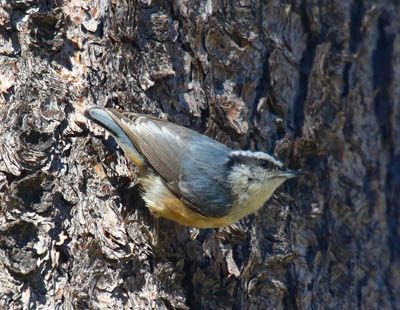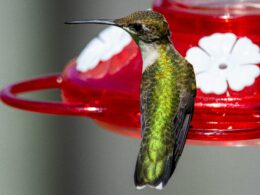Last Updated on January 24, 2024 by Greg Gillson
Red-breasted Nuthatches are small birds that live in conifer forests of the north woods and West. In winter some of the northernmost birds migrate south, irregularly in large numbers. They visit backyard pine and spruce trees and frequent bird feeders where they eat black oil sunflower seeds, suet, and other bird foods. You may first note them as a tiny blue-gray bird with pale rusty breast crawling head-first down a tree trunk!
This page is a supplement to my overview of the Red-breasted Nuthatch. The overview page leads to other more in-depth pages on identification, range and habitat, nesting and reproduction, and back to this page on foods and diet.
 |
|
Red-breasted Nuthatch head-first down the tree!
Photo by Greg Gillson
|
Diet and natural foods
Red-breasted Nuthatches primarily eat insects in summer. Beetles, wasps, crane flies, moths, caterpillars, and insect eggs are included in their diet. They also eat spiders, ants, weevils, and earwigs.
The young are fed mostly on insects and spiders.
The larvae of the spruce budworm eat the needles and buds of conifers. This has caused much damage to northern and western forests during outbreaks. Red-breasted Nuthatches are one of several birds that eat these larvae and probably the little brown adult moths, too. Several references note that birds and insect predators act as natural controls of the spruce budworm, but don’t have much effect during massive outbreaks.
In winter, Red-breasted Nuthatches like to eat the seeds found in the cones of pine, spruce, fir and other conifers. But they can still find some arthropods such as bark beetles in the bark of trees. Other native nuts that they eat include acorns and beechnuts.
Conifer trees sometimes fail to produce a good cone crop. When there is a cone crop failure birds that feed on them move southward in large numbers. This is called an irruption (not to be confused with an eruption!). Frequently, several species of winter cone seed eaters irrupt together. Such birds can include Pine Siskins, Red Crossbills, Evening Grosbeaks, Red-breasted Nuthatches and others. In normal years these birds winter in the same region where they breed. But in irruption years, they may be found hundreds of miles south of their normal summer range.
Red-breasted Nuthatches at the backyard feeder
Foods to attract Red-breasted Nuthatches
If there are conifers in your neighborhood, especially in your own backyard, you may have Red-breasted Nuthatches visit your feeder, especially in winter.
The favorite seed at your feeder to attract nuthatches is going to be black oil sunflower seeds. These nuthatches are going to fly up and take them away, one at a time, to open and eat, or to cache away for later. I’ll tell you more about this when we discuss feeding behavior below.
In winter, Red-breasted Nuthatches are especially attracted to suet. This can be plain or with peanuts included within. With their strong feet and long toes they can hang on well to suet cages.
Speaking of peanuts, these little birds love peanuts! Offer them shelled, either whole or broken smaller. There are some bird foods that include tree nuts and peanuts that they’ll love.
Nuthatches will also enjoy mealworms, especially in a mix with nuts and sunflower chips.
Red-breasted Nuthatches will love peanut butter, too. You can spread it on the bark of a tree or mix it with seed or corn meal and put it in pre-drilled holes in special feeders or DIY pine cone feeder.
What is the best feeder for Red-breasted Nuthatches?
Except for suet feeders, Red-breasted Nuthatches do not spend long on the feeder. They grab food and fly off. So there is no special “nuthatch feeder.” Rather, nuthatches will visit any feeder offering black oil sunflower seeds and peanuts.
A metal mesh finch feeder offering black oil sunflower seeds will be easier for them to hang onto than one of the plastic-walled tube feeders. Tube feeders with trays on the bottom will be fine for them.
Red-breasted Nuthatches will visit a small hopper style bird feeder. These have trays to sit in.
Of course, these nuthatches will grab sunflower seeds from a larger platform feeder, too. It’s just that the larger feeder is likely to have larger (and more) birds. Nuthatches are quite small and may be kept away by too many larger and perhaps more aggressive birds. However, Red-breasted Nuthatches have been known to hold their own against other small birds.
There are some peanut feeders that nuthatches would use. But these seem like they’d attract more squirrels and jays than smaller birds.

Feeding and foraging behavior
Red-breasted Nuthatches are active and jerky as they crawl up and down a tree. They aren’t restricted to the trunk, however. They spend equally as much time investigating the bark on the branches for beetles. In fact, they may be seen acrobatically climbing on the outer needle clusters, as well. Occasionally, these birds may fly out to catch flying insects, too.
They forage singly or in pairs, unless you come across a family group with recent fledglings in summer.
In winter they join in a flock with other birds as they move through the forest, from tree-to-tree. It is rare, however, to see more than a couple of nuthatches in these foraging mixed flocks that have a core group of chickadees, and lesser numbers of kinglets, wrens, nuthatches, warblers, vireos, creepers, and downy woodpeckers.
These birds pry open the pine (or spruce or fir) cones with their bill in order to reach the seeds within.
When eating sunflower seeds at your feeder Red-breasted Nuthatches are very quick. They alight briefly, grab a sunflower seed, and immediately fly off to a tree branch to eat it.
Nuthatches cannot chew to open seeds as do sparrows, so the nuthatches take a seed and wedges it in a crevice in the bark. Then they use their bill to pound the seed or nut open to get the kernel inside. In fact, you might follow tapping in the woods thinking you will find a woodpecker, and have it turn out to be a nuthatch, instead.
Red-breasted Nuthatches sometimes cache food for winter. They store food to eat later. Rather than storing many seeds in one cache, these birds store individual seeds or nuts lodged into the bark of trees. They even cache away beetles! Usually, though, they cache pine seeds. There are reports of these nuthatches caching food on the ground and covering it.
Water
Red-breasted Nuthatches come to water to drink. As with most birds they are attracted to the sound of dripping water. They may be attracted to fountains and drippers and other artificial water sources, more so than a non-circulating bird bath.
Back to the Overview page for Red-breasted Nuthatch.
Wrapping Up
The red-breasted nuthatch is a charming and energetic songbird found in coniferous forests across North America. Here are some interesting facts about them:
Appearance:
- Distinctive features: They have a black cap and eye stripe, a white supercilium (eyebrow), and a rusty-cinnamon underbody.
- Size: They are small, measuring around 4.5 inches long with a wingspan of 8.5 inches.
- Sexual dimorphism: Females and young birds have duller heads and paler underparts compared to males.
Habitat and Behavior:
- Forest dwellers: They primarily inhabit spruce, fir, pine, hemlock, and larch forests in the north and western mountains. In eastern populations, they can also be found in deciduous woods.
- Busybodies: They are constantly moving and foraging on tree trunks and branches, searching for insects and seeds in crevices and under bark.
- Headbangers: Unlike woodpeckers, they don’t drill holes, but may use their bills to wedge nuts and seeds into bark crevices and hammer them open to access the food inside.
- Acrobats: Their strong feet with an opposable toe allow them to move up and down tree trunks with agility, even hanging upside down.
- Cachers: They often store nuts and seeds in hidden caches for later consumption, especially during winter when food availability is scarce.
Vocalizations:
- Trumpet calls: Their high-pitched, nasal calls sound like a tin trumpet being honked, earning them the nickname “tintrumpet bird.”
- Complex songs: Males have a complex melodic song used to attract mates and defend territories.
Nesting and Breeding:
- Natural cavities: They nest in natural cavities like tree holes or woodpecker holes, sometimes plastering mud around the entrance for protection.
- Cooperative breeding: In some cases, male offspring may stay and help their parents raise the next brood.
- Clutch size: Females typically lay 4-7 eggs, which are incubated for about 12 days.
Population and Conservation:
- Common and widespread: Red-breasted nuthatch populations are widespread and considered stable in most areas.
- Adaptability: They have successfully adapted to human-modified habitats like parks and gardens, often visiting bird feeders.
- Threats: Habitat loss and fragmentation due to deforestation and development can pose threats to their populations.
Frequently Asked Questions
Are Red-breasted Nuthatches rare?
Red-breasted Nuthatches are not considered rare, although their presence can vary depending on location and season. Here’s a breakdown:
Globally:
- Their global population is stable and they are classified as Least Concern by the IUCN.
- They have a vast range spanning coniferous forests across North America, extending from Alaska and Canada down to the western mountains of the United States and northern Mexico.
Local variations:
- More common in the north and west: They are generally more abundant in northern and western coniferous forests.
- Eastern populations: In eastern North America, their populations are more localized and less dense compared to the west.
- Irruptive nature: These birds have a tendency to undergo irruptions, making large-scale movements outside their typical range in years with low food availability in their breeding grounds. This can lead to fluctuations in their presence in certain areas during such irruptive years.
Seasonal changes:
- More visible in winter: They are generally more visible in winter, especially in eastern regions, as they venture out from coniferous forests in search of food, sometimes visiting bird feeders.
- Summer breeding: During the breeding season, they are more secretive and focused on nesting in cavities within their forest habitats, making them less readily observable.

Where can I find Red-breasted Nuthatch?
Finding Red-breasted Nuthatches depends on location and timing:
Habitat:
- Primary habitat: Look for them in coniferous forests, particularly those dominated by spruce, fir, pine, hemlock, and larch. In eastern North America, they can also be found in deciduous woods, especially during winter.
- Specific areas: Check areas with mature trees, fallen logs, and dense undergrowth, as these provide good foraging and nesting opportunities.
- Bird feeders: In winter, especially in eastern regions, they might visit bird feeders offering peanuts, suet, and sunflower seeds.
Location:
- Widespread: Their range stretches across North America, from Alaska and Canada down to the western mountains of the United States and northern Mexico.
- More common in the north and west: Their populations are denser in northern and western coniferous forests.
- Eastern populations: Look for them in eastern Canada and the northeastern United States, particularly in mountainous areas or coniferous forests near water.
Season:
- More visible in winter: They are easier to spot during winter months, especially in the east, as they come down from their breeding grounds in search of food.
- Summer breeding: In summer, they are more secretive and focused on nesting, making them harder to find.











That was an excellent article about Nuthatches.
thanks for ur information
can u tell me how can i make my nuthatch to sounds sooner
I'm sorry. I don't understand the question.